Samsung Galaxy S 4 Review - Part 1
by Brian Klug on April 24, 2013 12:01 AM ESTDisplay
We wrote about how we suspected that SGS4 would go to a 5-inch 1080p SAMOLED display just after CES. Turns out that was spot on, as the SGS4 includes a 5-inch 1080p Full HD SAMOLED panel, the latest in Samsung's AMOLED roadmap. Samsung's naming stays true, and there's no Plus tacked on at the end, so we get another non-RGB stripe subpixel geometry with SGS4. The last few Samsung AMOLED variants we've seen have had different subpixel grids, and the one on the SGS4 is possibly the most interesting to date. There's still a bias toward more green subpixels than blue or red, this isn't an RGB stripe at all, but instead of the previous RG,BG layout we see this offset pattern with green on one line, then blue and red on another line. Interestingly enough the blue subpixel appears to be a square, and red and green appear to be circles, with the difference in area possibly offsetting the luminous efficiency of each material. Whatever the reason (Samsung has never been official or forthcoming any of these subpixel patterns each time they've changed them) it's present on the SGS4.
At this size however I have to admit that I find the pursuit of the subpixel geometry more of an educational one than something which affects users. While I could occasionally see it on the SGS3, I definitely do not see it on SGS4. The subpixels are now small enough that whatever the pattern, it all looks like a homogenous light-emitting surface, which was the goal after all. I could bring up the visual acuity discussion again but just trust me that it's small enough to not be visible even with actually perfect (not legally perfect, which is different) vision.
So resolution is great and up to par with all the other LCD-bearing flagships this year, lack of RGB stripe notwithstanding. There's that remaining question about brightness, contrast, outdoor visibility, and of course calibration and the saturation issue that has persisted with AMOLED from generation to generation.
On the brightness front, the SGS4 includes dynamic contrast functions that cannot be disabled and change as a function of what is being displayed. There's an "auto adjust screen tone" checkbox under display but don't let that fool you, that doesn't disable dynamic contrast, just white point. Under screen mode are the mDNIe toggles we've seen on countless other previous Samsung Android phones with AMOLED panels, only here we notice something interesting. There have always been four toggles as long as this option has existed, only what's different is now, one of them is named "Professional photo." Reviews of other regional variants of the SGS4 have included the same button but marked "Adobe RGB." Oddly enough it seems that the North American versions at least have this renamed for some reason, but undoubtedly the function is the same. Many speculated that this is now a toggle for some full CMS (Color Management System) which "fixes" the inherent color space issues with AMOLED and oversaturation that occurs when looking at sRGB content on such devices. Unfortunately, I can confirm that my initial suspicions that this is just a continuation of the mDNIe (lite) settings from previous generation is in fact correct. I reverse engineered what I could of these settings from both kernel messages while changing the toggles, and looking at the kernel sources. Turns out that 'Professional photo' mode is actually the 'Natural' mode renamed from previous versions.
So the question was whether the color space or white point actually does change with this mode enabled. I ran the SGS4 through our display tests in each of the modes and think the full color space plot tells the story. The sanest of them all really ends up being the strangely-named 'Movie' mode. Professional photo gives the big gamut with a white point closer to 'Movie,' which is to say around 7000K, but it doesn't fundamentally change the still-present oversaturation or color management issue that exists in Android with these wide gamut displays. Most users admittedly don't care however and just see "bright" colors. Theres' an Auto mode as well which the device ships with that basically has a matrix of mDNIe settings for targeted applications (for example the Gallery, Browser, Video playback) and so forth get settings, which you can see in the kernel.
| CalMAN Display Comparison | ||||||||||||
| Metric | iPhone 5 | iPhone 4S | HTC One X | SGS3 | Samsung Galaxy Note 2 | Google Nexus 4 | HTC Droid DNA | HTC One | SGS4 | |||
| Grayscale 200nits Avg dE2000 | 3.564 | 6.162 | 6.609 | 4.578 | 5.867 | 7.686 | 6.738 | 5.391 | 7.511 | |||
| CCT Avg (K) | 6925 | 7171 | 5944 | 6809 | 7109 | 8506 | 8108 | 8118 | 7020 | |||
| Saturation Sweep Avg dE2000 | 3.591 | 8.787 | 5.066 | 5.460 | 7.986 | 8.517 | 5.856 | 3.365 | 7.823 | |||
| GMB ColorChecker Avg dE2000 | 4.747 | 6.328 | 6.963 | 7.322 | 8.185 | 7.531 | 6.687 | 4.656 | 7.440 | |||
In the "Movie" mode things are better controlled than the Note 2 on the GMB color checker card test, which is the most important one for me. White point is also no longer the crazy 8000K that we saw before, 7000K is commendable for Samsung at this point. Keep in mind that maximum brightness changes in each mode as well as we effectively clamp things, I measured a maximum of 319 nits in Dynamic mode, 311 nits in Movie mode, and 255 nits in Standard, for example.
Running the display at maximum brightness for too long will also get you into an overheating or thermal protection mode as well, which we've seen on countless other AMOLED variants. Most of the time I suspect users will run on Auto brightness however which keeps brightness down to a much lower level to save battery and prevent that from becoming a problem.
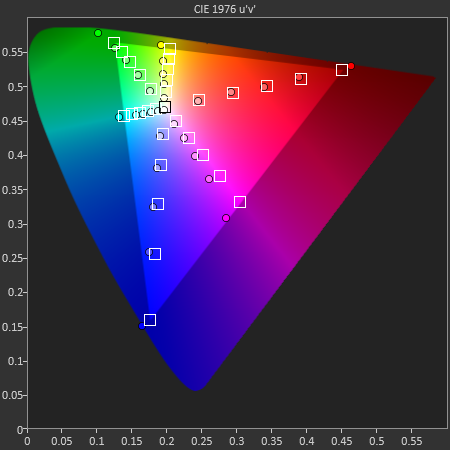
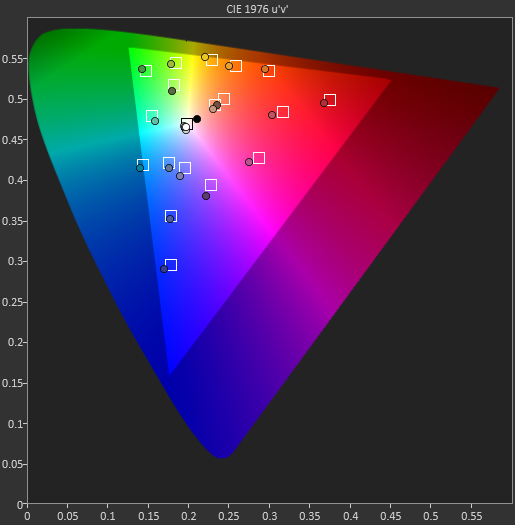
Because "Movie" was the closest to sRGB of all the modes, I selected it for the actual results that I'll present in the table. Admittedly this mode does tighten things up a bit, but it still isn't perfect and I'd still like to see Samsung do something to reign this in at some point.


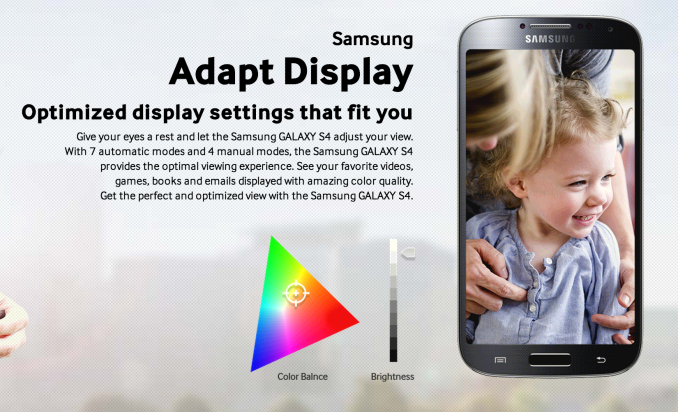




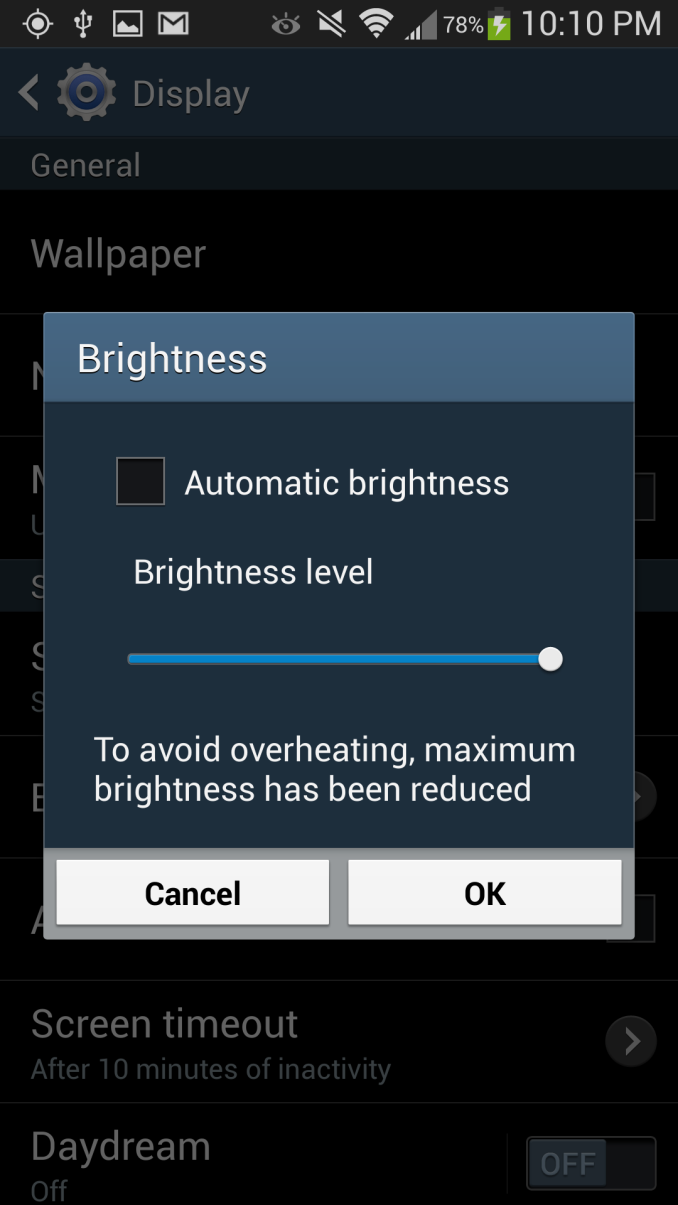
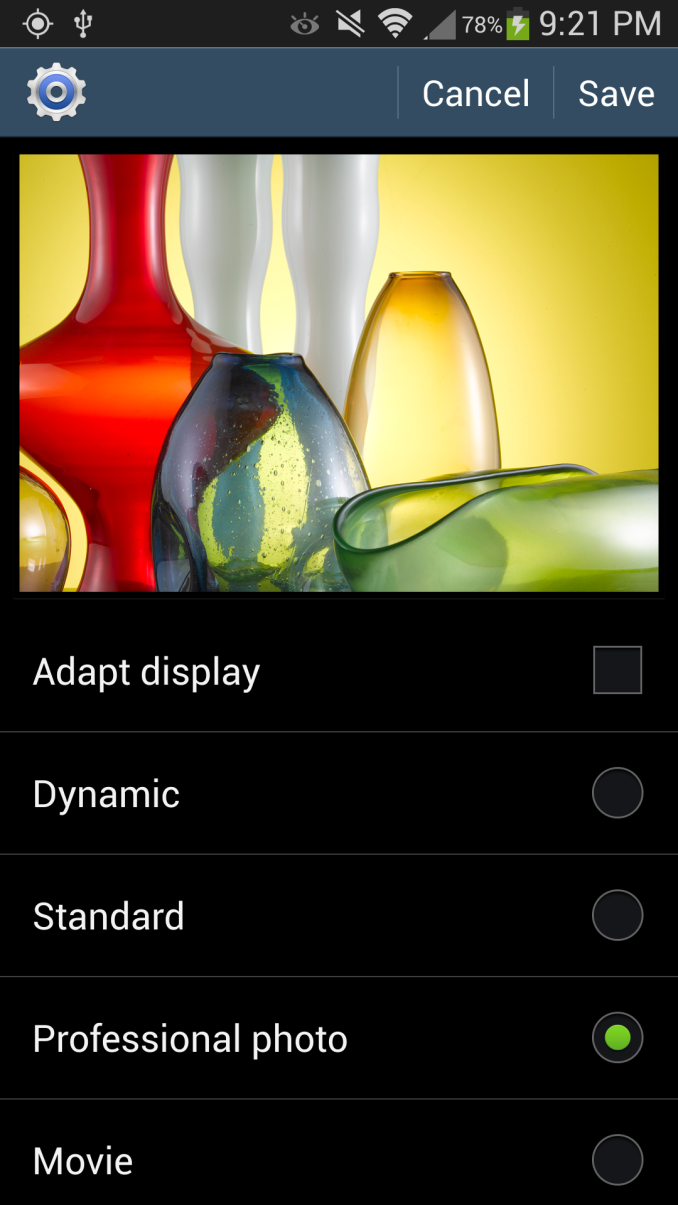
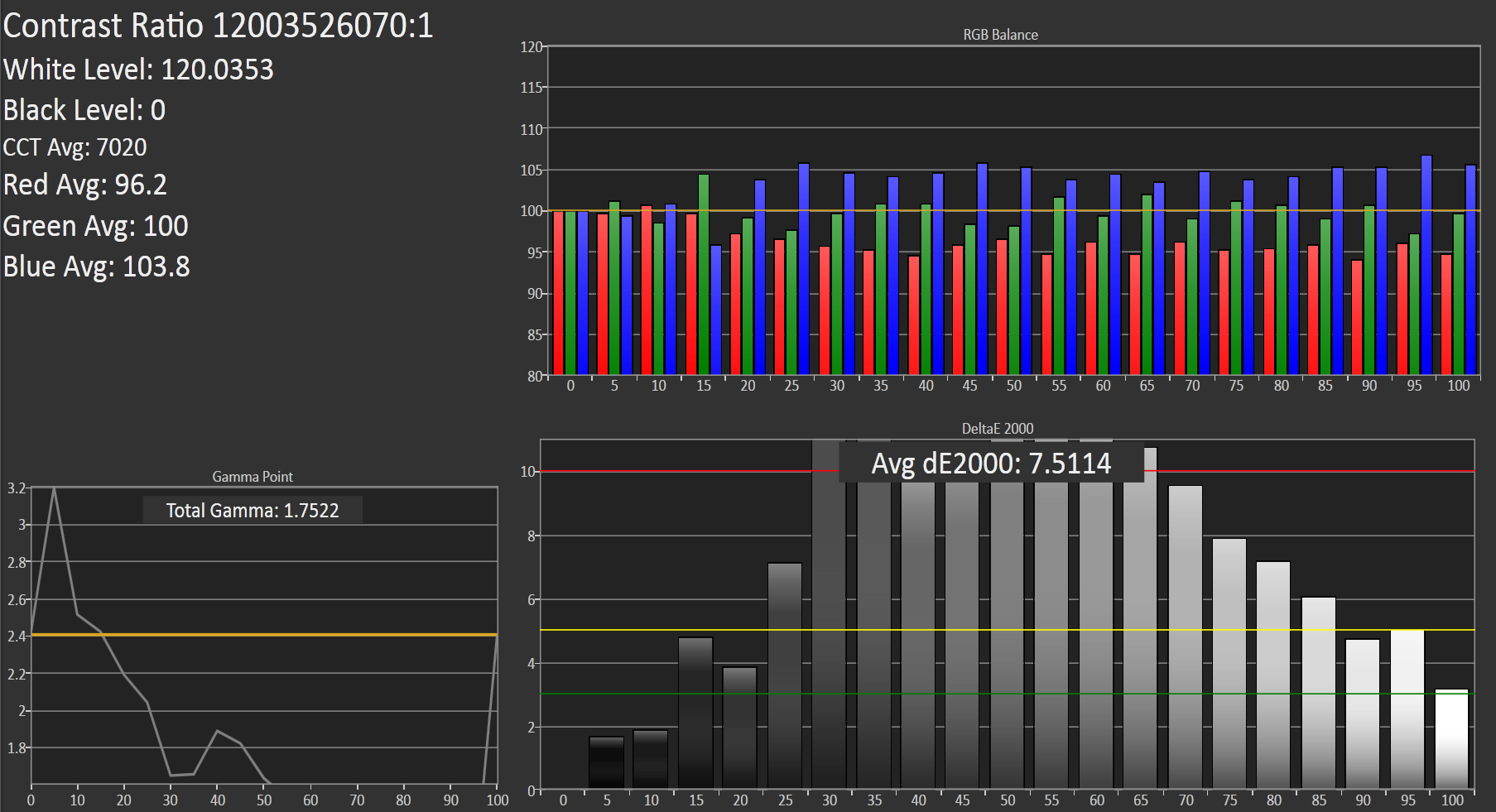








335 Comments
View All Comments
Reikon - Wednesday, April 24, 2013 - link
Um, you said the SGS4 beats the other phones on accuracy. I'm pointing out that you're wrong. And now when I do, you claim accuracy isn't important.And I have no idea what you mean by "dynamics." Do you mean contrast? It's shown on the charts even though he didn't separate them out. And preference between higher contrast and accuracy is a subjective one. You can't say which one people prefer more. Many people prefer accuracy more than "feeling."
krumme - Thursday, April 25, 2013 - link
You might want to look at the color charts again. The S4 beats the One on color accuracy.And yes the dynamics of the picture is the contrast for black white, and each of the individual colors. The S4 is what 100 times better?- ofcourse that does not directly translate into perception, but everyone can see the difference. Everyone prefers the livelyness of the picture here.
You better get used to it. Every high-end phone will have amoled in 2 years. The reason only Samsung have it now, is because they are the only one who masters it on this production scale.
sigmatau - Thursday, April 25, 2013 - link
Good luck with the S4 in sunlight unless you don't crawl outside at all.krumme - Thursday, April 25, 2013 - link
Yeaahttp://www.gsmarena.com/samsung_galaxy_s4-review-9...
UpSpin - Thursday, April 25, 2013 - link
That review is pretty inconsistent:'The brightness levels of the Samsung Galaxy S4 are about on par with the rest of the company's AMOLEDs, which is to say not very high. However, due to their low reflectivity, this doesn't affect outdoor performance'
But a a few lines below they suddenly write:
'The Galaxy S4 is a solid performer outdoors, although surprisingly not any better than the Galaxy S III, despite its slightly higher brightness. Perahps, the new Gorilla Glass causes a dash of extra reflections and offsets the advantage.'
So it's as bad as the Galaxy S3. First they say it shouldn't be reflective, but then they say it's even more reflective than the S3, which already has a poor outdoor performance, just google for something like 'galaxy s3 outdoor visibility' and you'll see that people aren't happy with it outdoors.
Your mentioned review also says:
'Its impressive contrast and almost perfect viewing angles make everything on the screen pop, regardless of your viewpoint. '
Which is exactly the opposite to:
http://www.phonearena.com/reviews/Screen-Compariso...
'Then come the AMOLED displays of the Galaxy S4 and Galaxy S III, which are quick to become bluish even when looked at a slight angle. Otherwise, they do well retaining relative contrast and brightness. However, the quality LCD screens of the iPhone 5 and One do equally well, and even manage to retain a more natural color balance'
Phonearena however does not only write some false stuff, but also proof their statements with pictures.
Regarding outdoor usability they say:
'This lack of brightness also leads to worse visibility in outdoor conditions for the AMOLED screens. The Galaxy S4 isn't unusable, but it's perceptibly harder to read than the bright screens of the Apple iPhone 5 and HTC One, which lead the pack in this respect.'
krumme - Thursday, April 25, 2013 - link
Spin it what ever you want, but gsmarenas measurements, not personal assessments, show the S4 to have a sunlight contrast ratio of 3353 vs. 2500 for the One. No other way to put it.I dont know about phonearena. Their review is 4 small pages, with no measurements only blog talk. They give S4 a higher rating than One, but i would not put to much credibility in this blog.
And you say Phonearena had pictures? Yeaa i know i look at them with both new oled, ips and pls screen. Have you read their camera comparison?
http://www.phonearena.com/reviews/Camera-compariso...
sigmatau - Thursday, April 25, 2013 - link
My personal assessment shows that you can't read shit on a Samsung OLED screen outside. Even Anand said that the HTC One's screen kills the S3's. We are talking about the screen, btw, not the camera. Nice try of a deflection.krumme - Friday, April 26, 2013 - link
If you leave the S4 in automatic brightness mode, the screen can go as much as 34% brighter compared to the maximum of manual mode. That’s 68% brighter than the maximum of the Galaxy S IIIhttp://www.displaymate.com/Galaxy_S4_ShootOut_1.ht...
There is a difference to Oled screens you know.
hyperdoggy - Wednesday, April 24, 2013 - link
yes, yes...and yes?krumme - Wednesday, April 24, 2013 - link
remember to charge between each "yes"